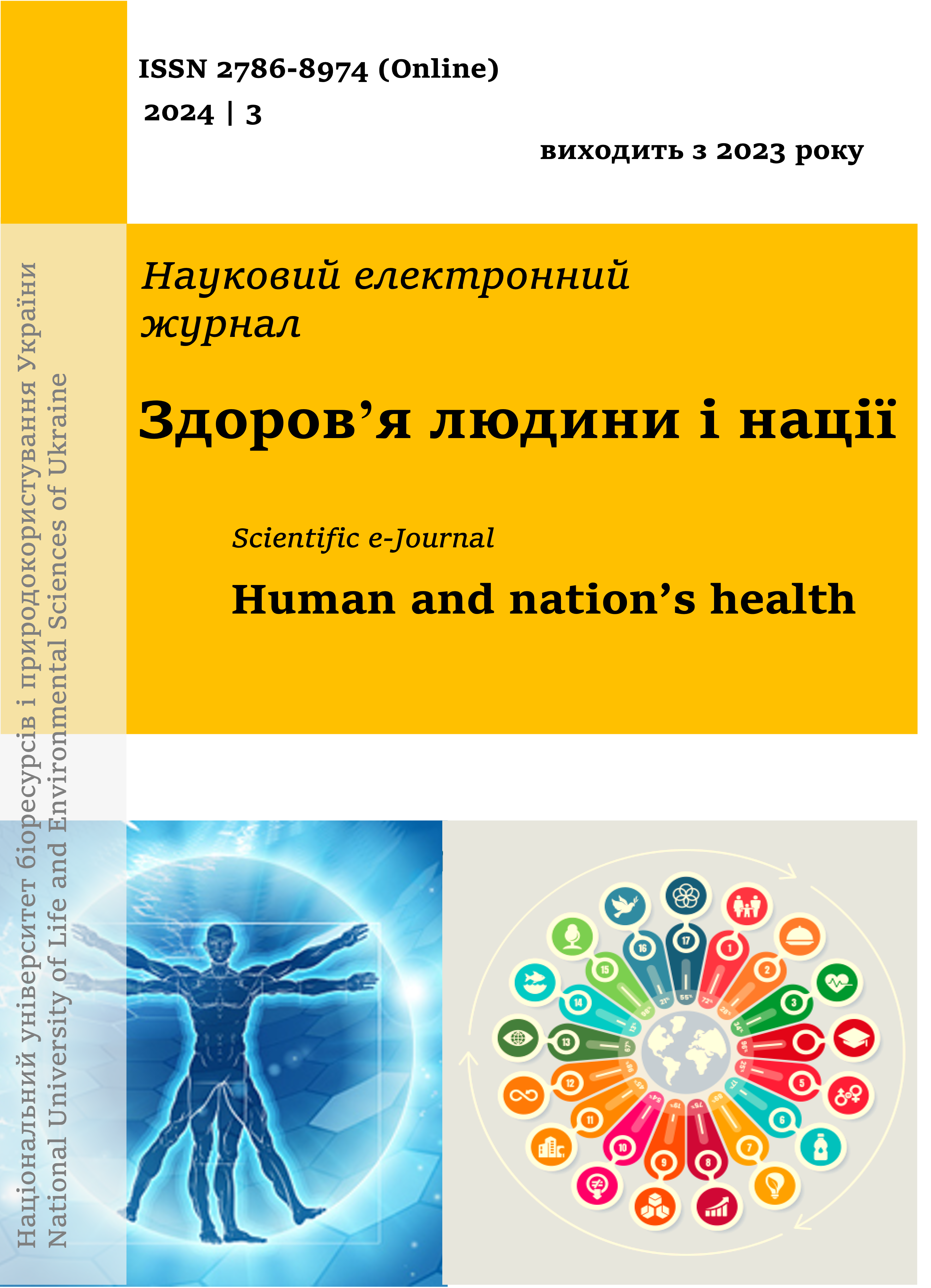Methodology of sensory analysis in improving the technology of canned fruit beverages
DOI:
https://doi.org/10.31548/humanhealth.3.2024.94Keywords:
sensory analysis, biological and nutritional value, canned food, profile, marketAbstract
The Ukrainian fruit juice market is competitive and consumers prefer products that have high organoleptic characteristics and retain the maximum amount of nutrients. The study analyses the current state of the fruit beverage market, in particular apple juice, in Ukraine, with a focus on organoleptic properties that influence consumer choice. The relevance of the study lies in the need to improve the technologies for the production of canned fruit juices, in particular apple juice, to ensure compliance with modern consumer requirements for product quality and safety. The fruit juice market in Ukraine is competitive and consumers prefer products with high organoleptic characteristics and retaining the maximum amount of nutrients. Given the change in consumer preferences and increased interest in healthy eating, there is a need for a comprehensive analysis of consumer expectations and sensory properties of products. The aim of the study was to identify the main factors influencing consumers' choice of apple juice, assess the quality of products of the five leading brands in the Ukrainian market (Nash Sik, Jaffa, Galicia, Rich and Biola), and develop recommendations for improving organoleptic characteristics to increase the competitiveness of products. Based on the developed questionnaire, a survey was conducted to determine consumer preferences and the formation of the juice market. The results of the survey revealed a high level of consumer interest in new types of varietal fruit juices, which underlines the importance of research in this area. The main results of the study showed that the juice of the Rich brand meets consumer expectations the best, particularly in terms of taste and aroma. Consumers noted the importance of naturalness of products and the absence of artificial additives, which emphasizes the need to improve production technologies to preserve the natural composition and taste. Recommendations have been developed to improve the quality of apple juice, including optimization of technological processes, increasing the content of nutrients in the final product and ensuring compliance with consumer expectations. The results obtained can be used to increase the competitiveness of products in the market and expand the range of fruit juices in line with current trends in healthy eating.
References
Analysis of the juice market in Ukraine. (2021). Retrieved from https://pro-consulting.ua/ua/issledovanie-rynka/analiz-rynka-sokov-v-ukraine-2021-god
Angrainy, R., Fitri, L., Nova, S., Putri, M., & Khairiyyah, N. (2024). Effectiveness of consuming celery leaf juice in reducing high blood pressure in elderly. World Journal of Advanced Research and Reviews, 21(3), 146-149. Retrieved from https://mail.wjarr.com/sites/default/files/WJARR-2024-0711.pdf
Boyko, V., Kovalenko, Yu., & Krivoruchko, V. (2016). Development trends of the Ukrainian juice market. Accounting and finance of agriculture.
Drozdova, V. (2016). Analysis of the external environment of the juice production industry. Accounting and finance.
Ghanim, H., et al. (2010). Orange juice neutralizes the proinflammatory effect of a high-fat, high-carbohydrate meal and prevents endotoxin increase and Toll-like receptor expression. The American Journal of Clinical Nutrition, 91(4), 940-949. https://doi.org/10.3945/ajcn.2009.28584
ISO 8586:2023 Sensory analysis – Selection and training of sensory assessors Access mode. Retrieved from https://www.iso.org/standard/76667.html.
Kaur, C., & Kapoor, H.C. (2001). Antioxidants in fruits and vegetables: The millennium's health. International Journal of Food Science and Technology, 36(7), 703-725. Retrieved from https://ifst.onlinelibrary.wiley.com/doi/abs/10.1111/j.1365-2621.2001.00513.x.
Kudryk, M., & Steblina, K. (2011). Study of juices with pulp. Bulletin of the Poltava State Agrarian Academy.
Lawless, H. T., & Heymann, H. (2010). Sensory evaluation of food: principles and practices. Springer Science & Business Media.
Manoli, T. A., Kameneva, N. V., Vasylyk, O. V., & Barysheva, Y. O. (2024). Modern methods of sensory analysis. Odessa National Technological University.
Market of juices, smoothies and fruit puree in Ukraine: current situation. (b. d.). Market analysis. Retrieved from https://pro-consulting.ua/ua/pressroom/rynok-sokov-smuzi-i-fruktovogo-pyure-v-ukraine-tekushaya-situaciya
Meilgaard, M. C., Civille, G. V., & Carr, B. T. (2016). Sensory Evaluation Techniques. 5th Edition. CRC Press
Melnyk, I. (b. d.). Development trends of the Ukrainian juice market. Accounting and finance of agriculture: an educational portal. Retrieved from https://magazine.faaf.org.ua/tendencii-rozvitku-ukrainskogo-rinku-sokiv.html
New technology juices up the food industry. (b. d.). Latest breaking news available as free video on demand | Euronews. Retrieved from https://www.euronews.com/next/2018/02/05/new-technology-juices-up-the-food-industry
Novikova, N. V., & Protsenko, G. Y. (2024). Analysis of raw materials and development of apple jam with the addition of hazelnuts, cinnamon and lemon peel. Tavriyskyi naukovyi vestnik. Series: Technical Sciences, (2), 154-160.
O. B. Tkachenko, N. V. Kameneva, & T.A. Manoli (Eds). (2020). Basics of sensory analysis of food products. Odesa: Helvetica. Retrieved from https://card-file.ontu.edu.ua/items/1a13fd8a-c435-4104-ab5a-eca91a4fc44d
Prior, R.L., Wu, X., & Schaich, K. (2005). Standardized methods for the determination of antioxidant capacity and phenolics in foods and dietary supplements. Journal of Agricultural and Food Chemistry, 53(10), 4290-4302. Retrieved from https://pubs.acs.org/doi/abs/10.1021/jf0502698
Sagaidak, I. S., & Kachur, I. V. (2023). Instrumental research methods and sensory analysis. State Tax University.
Storozhenko, D. S., Pinkevych, V. O., Novosel, O. M., & Novosel, E. N. (2018). Organic acids of domestic apple tree leaves of Williams Pride variety.
Technical standardization committee "Juices and juice-containing products" (TC 154). (b. d.). Canned food juices and juice products cocktails. General specifications (DSTU 8074:2015).
V. Neveu, J. Perez-Jiménez, F. Vos, V. Crespy, L. du Chaffaut, L. Mennen, C. Knox, R. Eisner, J. Cruz, D. Wishart, A. Scalbert, Phenol-Explorer: an online comprehensive database on polyphenol contents in foods, Database, Volume 2010, 2010, bap024, https://doi.org/10.1093/database/bap024
Vats, S., Kaushal, M., Vaidya, D., & Gupta, A. (2024). Stability of Sugarcane Juice with Blanching and Acidification: Biochemical Analysis, Sensory Evaluation and Storage Studies. Sugar Tech, 26(3), 657-667.
Vikul, S. I., Zhitkevich, A. O., & Kornetsova, K. P. (2020). 140242 Composition of ingredients for the preparation of green smoothie. Retrieved from content (ontu.edu.ua).
Downloads
Published
Issue
Section
License
Copyright (c) 2024 Human and nation's health

This work is licensed under a Creative Commons Attribution-ShareAlike 4.0 International License.
All materials are distributed under the terms of the Creative Commons Attribution 4.0 International Public License, which allows others to extend the article with acknowledgment of authorship and first publication in this journal.

